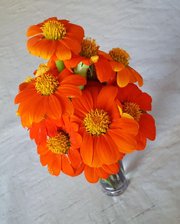Q With the forecast showing temperatures close to freezing ahead what do I need to do with my outside tropical plants?
A We have had a much hotter fall this year than normal, so many people have delayed moving their houseplants indoors, but it is now time to move anything that you plan to keep as a houseplant. Even if we don't have a killing frost, when plants start being exposed to nighttime temps in the low 50s and below, they harden off in preparation for winter. If you then move them into a heated house with less light and no humidity, they shed foliage and look awful. When inside and outside conditions mirror each other is the time to move plants inside. If you have plants that you plan to overwinter in storage and do not expect to bring them inside, then move them to their protected storage space before a frost so they don't die. They can be stored in a basement, garage or storage unit provided the space doesn't drop below freezing.
Q Can you help identify this plant [not pictured]? All I was told was it is a citrus plant. It has never bloomed or produced any fruit in 17 years. It has never grown higher than about 7 inches tall. Has beautiful half-inch to 2-inch thorns. Top of plant turns gray while bottom stays green. I'm sure I have it planted in the wrong place. I intend to transplant it to a large tub with rollers, but I would like to know what type of soil additives it needs to do well.
A All I can tell you is that it is a citrus tree. They all look similar when there are no fruits. Most citrus plants will do quite well in containers and can set fruit. The key is to give them full sun outdoors in the summer and move them inside to a sunny location for the winter. How much sunlight does your plant receive? In order to bloom, it does need six to eight hours per day. They can flower off and on all year in the right spot. The flowers are quite fragrant. How often do you repot it? If it is root-bound, it won't produce much top-growth. Next spring when you move it outdoors, repot using a slightly larger container, but shave off some of the old roots as you add new soil. Fertilize monthly throughout the growing season and keep it watered, and hopefully you will see some flowers and fruit. I must say you are more patient than I would have been. Seventeen years is a long time with no results.
Q Do you have a recommendation for keeping cats out of my outside planting area? They are using it as a scratch box. Gross.
A Mulch with sweetgum balls, and they will stay away. They typically scratch as they do their business and they don't like the sharp, spiny sensation.
Q Now that fall is here, and a good time to plant trees, may I say a word on behalf of sugar maples? I live in Rogers, and in the older parts of town there are many grand sugar maples, but they are dying out. In the newer sections, if people plant maples at all, they are the newer cultivars of red maples. These are OK, but their fall color lacks the vibrant glow of sugar maples. We need more ginkgos planted, too.
A There is nothing prettier in the fall than a sugar maple, and they definitely outshine red maples, but they are not so easy to grow in Arkansas. There are two species commonly called sugar maple -- Acer saccharum and Acer barbatum (which is sometimes called the Southern sugar maple). The southern species is much more heat- and drought-tolerant but not as showy as the common sugar maple. Sugar maples prefer a cooler summer than we get. You will find sugar maples throughout Arkansas, but they cannot compete with sugar maples in New England. Another harder to find replacement would be the native chalk maple (Acer leucoderme). I too love ginkgo, which have brilliant yellow fall color. Some other show stoppers in the fall landscape include blackgum, Chinese pistache, sourwood and the often despised sweetgum.
Q Can you tell me what this wildflower is? It has big orange blooms, started blooming in late September and is 4 to 6 feet tall. They are bigger than zinnias. The stem is hollow. Can we save the spent blooms and plant next year?
A It is not a native wildflower but a great annual that is native to Mexico and Central America called Tithonia or Mexican sunflower. The bright orange zinnia-like blooms are born on stalks that are 4 to 6 feet tall. It grows that much in one season, then dies after a killing frost. You can save seeds to replant next season.
Janet B. Carson is a horticulture specialist for the University of Arkansas Cooperative Extension Service. Write to her at 2301 S. University Ave., Little Rock, Ark. 72204 or email her at
HomeStyle on 10/28/2017


